When I’m invited to teach at an SFG I StrongFirst Kettlebell Instructor Certification, I always request to lead the military press. I love teaching the military press and, pardon my lack of modesty, I’m very good at it. An average gym rat might classify the kettlebell military press as just another exercise for delts and triceps, but it is so much more. It is a full-body lift that requires mastery of a large set of skills and the ability to use them in unison. This article is the first of two that will teach you how to safely test your press, find your weak areas, and apply appropriate drills to master your press.
The Physical Benefits
Pressing a heavy kettlebell overhead and holding it in the lockout position, requires movement mastery and full control of everything that’s under the kettlebell. It requires the ability to stack the bones under the load and maintain this position from the start in rack position to the overhead lockout. Every joint under the handle must remain under full control during a heavy press, including the wrist, elbow, shoulder joints, hips, knees, ankles, and feet. All related muscles must be under full voluntary control due to the fact that some joints move while others must stay locked. This body mastery achieved through perfecting the military press transfers to performance and stability in all the other lifts.
Pressing overhead is the premium anti-sedentary movement. Most of our lives are spent seated in front of a desk, at the dinner table, in our car and, for too many of us, on our living room couch. The majority spends the greater part of the day with bent knees and hips, a rounded back, internally rotated shoulders, and a protruded neck. Not healthy. Pressing overhead from a standing position clears it all with planted feet, straight knees, fully extended hips, a straight back, an open chest, and the head over the shoulders. In other words, a healthy, strong, and beautiful posture.
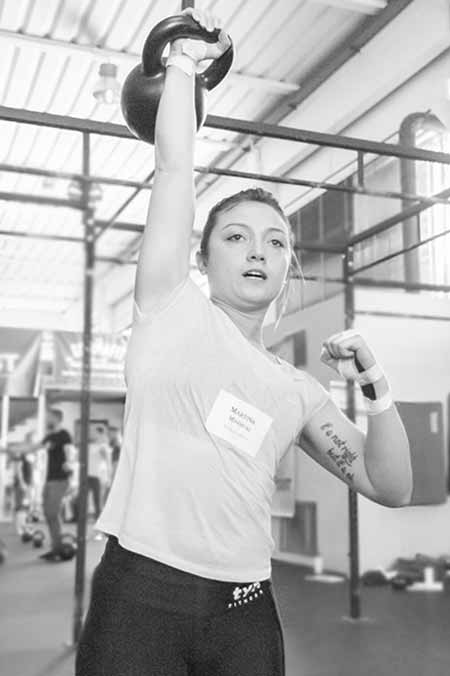
The Psychological Benefits
The psychological benefits of pressing also deserve consideration. What is the typical posture of a person who is weak and lacks self-confidence? Bent hips, a rounded back, internally rotated shoulders, a protruding neck, and downward gaze. What is the posture of a strong and self-confident person? A tall posture, proud and open chest, head over the shoulders, and a gaze directed straight ahead. What does a person who has just won a world championship do? They throw their arms overhead in victory. What was the sensation you felt the moment you pressed a heavy kettlebell and set a personal record (PR)? You probably felt strong, self-confident, proud, and victorious. Most likely you wanted to hold that lockout position and show the world what you accomplished.

Rocky Balboa
Before we begin teaching the military press at the SFG I certifications we often say, “The secret to happiness is picking a heavy kettlebell off the ground and pressing it overhead!” Initially, most participants think we are joking. By the end, they know we are not.
Perfecting the Press
In his article “The Best Press Exercise,” Pavel writes, “The kettlebell military press is the healthiest in the line-up, thanks to its shoulder mechanics. Its downside is it demands a high volume of training to keep moving. There are men and women who have succeeded in pressing a heavy kettlebell or a pair of them on a low volume regime, but they are an exception, rather than the rule. Usually, it takes 50-100 weekly reps to keep progressing.”
The press must be practiced frequently to keep up with the high training volume required for progressing. However, it is unwise to practice a lift frequently at high volumes without perfect execution; therefore, mastering the skill of pressing is a priority.
To perform a strong and safe one-arm kettlebell military press you must:
- Press from a solid foundation.
- Press along a perfect groove (for you).
- Use perfect timing.
Press from a solid foundation
At our kettlebell instructor certifications we ask our students, “Would you shoot a cannon from a canoe?” The answer is, of course, no. If you want to achieve a strong press, your body must remain stacked and tensed under the kettlebell throughout the entire movement. You must exert full-body control and prevent any leakage of tension or loss of balance, directing the weight straight to the ground through your tensed body.
Press along a perfect groove (for you)
In physics, work equals force times displacement (W = F • s). In geometry, the shortest distance between two points is a straight line. Taking these into consideration, we can assume the prime pressing groove is along a straight line. Unfortunately, things aren’t so simple. Our joints allow our limbs to move around rotational axes creating arcs of circumference. Even our straightest movements are the summation of different arcs generated by the various joints involved. Differences in proportions of limbs and other body parts, as well as achievable ranges of motion involved in the press, cause considerable differences in individual pressing grooves. Therefore, while there are staples and strategies that work for everyone, you must individualize and practice to find your own perfect pressing groove.
Use perfect timing
We have established that the one-arm kettlebell military press is a full-body lift and that you must exert full control of everything under the kettlebell throughout the movement. Part of your body performs the press, while the rest turns into a solid piece of rock. These two parts must happen at the same time, almost. Your body must turn into a rock a fraction of a second before you initiate the press. If you create tension too early, you will fatigue and most likely compromise your performance. If you are late, the result will be even worse and you’ll be “shooting your cannon from a canoe.” Perfect timing is key to a strong press.
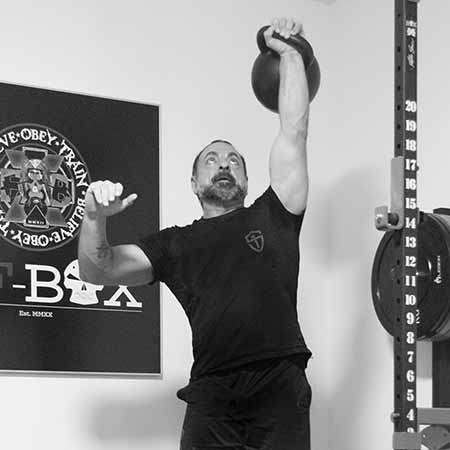
When Things Get Heavy
Learning the principles above and being able to apply them is relatively simple with a light weight. But when the kettlebell gets heavy, it becomes very challenging to keep everything in its place and often things fall apart. As StrongFirst Certified Master Instructor Mark Reifkind said, “Everything is easy until it gets heavy.”
If your press breaks down when things get heavy, the following instructions are written for you. I’m going to teach you how to find your flaws and fix them. It is not possible to cover every potential defect in one article, but I will cover the main ones. The first step is identifying your weak areas, which requires you to push your pressing weight to the limit or as close as possible. As you approach your limit, it is important to keep in mind how to do this safely. The purpose is not to press a heavy weight at all costs, but rather to do it with intention. You must know when you are beat and try again another day. Fail with integrity.
Below are some key safety points for a heavy press written by Brett Jones, StrongFirst Director of Education:
- A confident clean sets up the press.
If you struggle to clean the kettlebell into rack position, you will not be set up for a solid press or max attempt.
- Use a spotter or be able to drop/bail out safely.
You must be able to safely drop/bail out or work with a skilled spotter who can save the lift and protect you during an attempt.
- Grind, but recognize when to stop the attempt.
A heavy press will challenge our form and while we want to grind, it is also necessary to know when to stop. For example, if you change “shape” during the attempt (lean back for example) or lose your breath/brace it is time to stop.
- “Expect the unexpected.”
Trite, but true. You may not expect the kettlebell to roll in on you during a max attempt, but due to a change in form during the attempt it can happen. Expect it and be willing to apply #2 and #3.
- Just because the kettlebell went up, does not mean it was a PR.
Leg drive and side lean increasing during the attempt are “sneaky” and not catching those can have you training with or going for a PR that you are not prepared for.
Now, keeping these in mind, it is time to test your press.
Testing Your Press
The warm-up
Begin by doing your customary warm-up and movement prep. Then ramp up by completing 1-2 sets of triples, doubles, and singles building to a weight that is close to your one rep max (1RM). Take generous rest intervals between the ramp-up sets. Don’t fatigue during your first sets.
Now you are ready.
The test
Film all testing attempts. Filming your reps for technique assessment is the only reason your cell phone should be allowed in your training space (in airplane mode, of course). Pick up the kettlebell that is close to your 1RM and complete a single rep. Even if you feel you could complete more reps, press it for one rep only on both sides.
After a generous rest, no less than five minutes, attempt another single rep with your PR weight on both sides. Do not worry about completing the reps. You are simply testing how well you maintain perfect form under a heavy weight. The test is over if you fail your PR attempt and only one rep was possible with the kettlebell close to your 1RM.
However, if you felt you could do more reps with the kettlebell close to your 1RM, regardless of a successful PR attempt, you are not done. Rest, no less than five minutes, and do as many reps with the kettlebell close to your 1RM as possible on both sides. Now, the test is over. You should have two or three videos of your attempts and it’s time to go to the movies.
The movies
Analyze the videos of your attempts and pay attention to what your body is doing, especially during struggle or failure. Watch it multiple times at regular speed, in slow motion, and pause it when you notice a detail that deserves your attention. Do your homework. This careful analysis will help you discover your weak links and the appropriate drills to apply.
If the kettlebell stayed in the groove and your body maintained its shape under the stress of a near-maximal load during failure, you may not need to apply specific drills to address your weak areas. If you noticed yourself panicking under the heavy kettlebell, turning your press into a push press, or cheating in any way it is time to take a step back. Revisit and practice the basics of tension and strength. It might take months until you are ready to test again. If what went sideways in your technique includes allowing the kettlebell to slip out of the groove, losing total body tension (especially on the unloaded side), or failing the perfect timing, I have some good stuff for you. Stay tuned for my next article, “Mastering Your Press, Part II.”
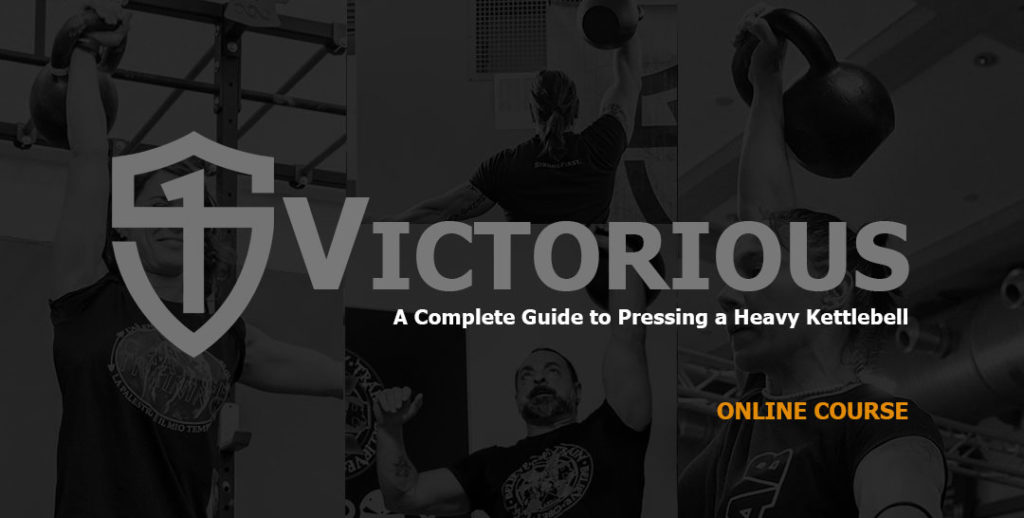


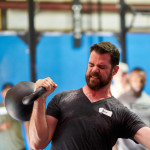
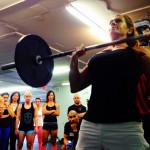


Great stuff, Fabio! I have also enjoyed watching the Victorious course (I am half way through it) and listening to you on various podcasts 🙂
Maybe this is covered at the end of Victorious, but how do the two plans differ in terms of outcomes? Are there any pointers for choosing between the two?
Thank you, Bauer!
Thank you for watching the Victorious course and for listening to the podcasts in which I’m hosted, I’m honored.
As far as for the plans, I would certainly start with Victorious I and progress with Victorious II once completed the first plan. They work very well when performed in a row. This unless one has already just been through another press plan based on a single bell size with waiving volume, such as John Spezzano’s “get stronger with one kettlebell”, in which case they can start directly with Victorious II.
Great article. Would be interested to get your take on pressing one kettlebell vs doubles and whether your enthusiasm is the same for both (and why). Thanks!
-Brett
Thank you, Brett!
I like both the single and the double versions.
However, I find the single press more user friendly as the double press requires more shoulder/t-spine mobility and hence is not appropriate for everyone. Also, for the double press one need to have access to double bells of the same size, which is not something that everyone has. Unless one does a double press with uneven bells, which is also interesting, but also not for everyone.
Me too!
Excellent…thank you Fabio!
Thank you, Cole!